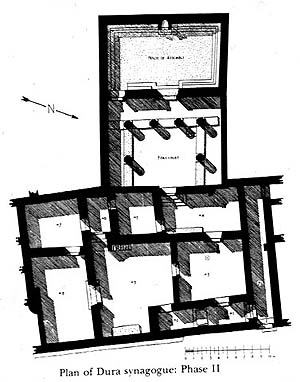SYNAGOGUE OF DURA-EUROPOSThe Synagogue discovered in Dura-Europos is one of the temples of the various religions existing in Dura at that time. It shows that there were a few Jewish families. Some were Christians and the rest of the population had adopted other religions prevailing in the Roman Period. The building comprises a court flanked by three porticos, an aisle reserved for the priests and the rectangular sanctuary measuring 13.35 by 7.70 m and 7 m high. It has the main dour in the middle for men and a second smaller door for women. The east and west walls have apertures to let the light in. There are benches fixed on the floor to all the four sides of the wall to seat the worshippers. Separate benches for women are between the two doors. The interior has mural paintings in four rows. The three upper rows depict scenes from the Old Testament, whereas the lower one shows a tiger, a lioness and a mask not relating to the upper scenes. The ceiling of the Synagogue is decorated with terracotta square slabs bearing motifs incarnating flora in human forms, or forms of flowers, roses, fruits and corn-ears etc. The murals of the Synagogue have a marked local touch. The Syrian temples were decorated with motifs unknown in the temple of other countries. The scene which depicts a temple is marked by the Corinthian style which was widespread in Syria at that time. Important among the unearthed inscriptions is an Aramaic text consisting of 15 lines revealing that the Synagogue was founded in 556 of the Seleucid Calendar i.e. the second year of the accession of Emperor Philip the Arab to the throne of Rome.
|

